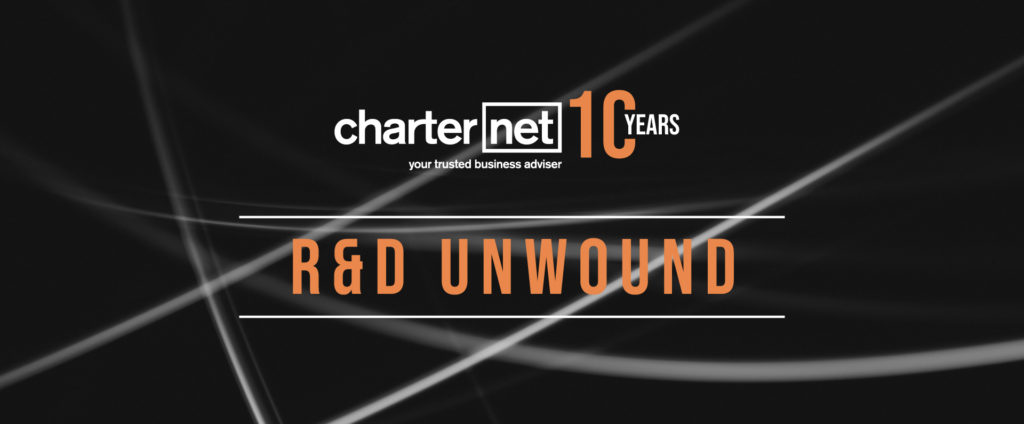R&D
R&D Unwound
CharterNet has launched a quarterly update surrounding all things R&DTI to provide claimants with the most up to date information given the fluid landscape of the R&D Tax Incentive in recent years. The quarterly publication covers areas including changes to legislation, R&DTI related news, case studies and more.
R&D Portal
Effective 5 July 2021, AusIndustry launched an online portal to process all R&DTI applications. All claimants must now link their myGovID to their company’s ABN and authorise access via the ATO’s Relationship Authorisation Manager to lodge a R&D application.
The portal is expected to make registering for the R&DTI easier, but there have been technical difficulties in the initial rollout. CharterNet recommends using Google Chrome when accessing the portal or attempting to receive authorisation as other browsers have been found to be unreliable. Additionally, if your connection is timing out, try again during off-peak hours.
Compared to the previous application process, there were significant delays in turnaround when the portal was first released. Initially, AusIndustry was taking up to 15 days to issue a Notice of Registration. CharterNet has already seen this turnaround time decrease and is hopeful that the portal will result in a more efficient lodgement process.
Additionally, with the release of the portal came a restructuring of the application form that should lead to claimants having a greater understanding of each stage of R&D. The updated structure has an increased focus on experimentation and provides more detailed guidance regarding what is required in each section. The portal has imposed a hard character limit in each section and applicants are no longer able to attach attachments to expand on their claims. This indicates a desire from the AusIndustry to see more succinct and clear applications which claimants now must balance succinctness and level of technical detail to ensure they are putting their best foot forward with their applications.
Ultimately the portal should make it easier to register for the R&DTI, but you should expect the adjustment period to last for a few more months.
Recent Court Cases
There have been a number of R&D related court cases in the past 12 months regarding claim eligibility. Each case discusses legislation and regulatory guidance and there has been an emphasis on the importance of a hypothesis in successful R&D applications.
In a 2017 case, it was determined that a hypothesis cannot be created after the completion of experimental activity with the benefit of hindsight. Generating a hypothesis after the fact does not meet the legislated requirement of following a systematic progression of work, going from hypothesis to experimentation to conclusions. There has been uncertainty regarding the need for documentation following the 2017 case.
The case of Royal Wins and Innovation and Science Australia in October of 2020 found that it is an essential aspect of the systematic progression of work that documentation be recorded and maintained, including the hypothesis at the very outset of activities. This case highlighted the importance of physical documentation, particularly for software companies.
In March 2021, the case of PKWK and Innovation and Science Australia affirmed the necessity of forming a hypothesis prior to beginning experimentation. The Tribunal found that there is also a duty on the regulator to approach the legislation with a degree of realism as companies are undertaking R&D in a commercial setting. The Tribunal found that in a commercial environment, activities are unlikely to be documented to the extent that might be observed at a university. The Tribunal also found that contemporaneous documentation is unnecessary, provided that there is other evidence of a valid hypothesis existing (including verbal evidence and tangentially related documents).
Any R&D claimant should be certain that there is a valid hypothesis prior to beginning experimentation, but the Tribunal has recently been leaning towards a commercially realistic approach to documentation. While credible oral evidence may mean that a hypothesis can be proven without substantial documentation, claimants should ensure that they are forming their hypothesis without the benefit of hindsight.
Recent R&D Announcements
The Patent Box Initiative would introduce a tax box that allows revenue associated with a patent or IP to be taxed at a lower rate of 17% for medical and biotechnology patents for income years commencing on or after 1 July 2022. The scheme has not been completely fleshed out and it is unclear how, or if, the patent box would interact with the R&DTI, how the program will be administered, and how to calculate the revenue associated with IP. Questions have been put out for consultation and further discussion is anticipated before the legislation is drafted.
Following up on the May 2021 announcement, the Board of Taxation is currently reviewing the administration process of the R&DTI and has put out a consultation paper. They are currently evaluating the effectiveness of the current dual agency approach, whether there is a clear differentiation of roles, and how the overall administration process can be improved. Currently, this is only an indication of intent, but claimants should be able to look forward to efficiency improvement in reviews and increases in the speed of returns.
The government announced in early May a 30% Games Tax Offset (DGTO) for businesses spending at least $500,000 on eligible expenditure effective from 1 July 2022. However, it is still unclear what will qualify for the offset, or what the administration of this initiative will look like.
If you have any questions, please contact your CharterNet team member.


